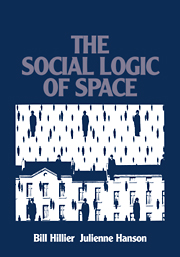Book contents
- Frontmatter
- Contents
- Preface
- Acknowledgements
- Introduction
- 1 The problem of space
- 2 The logic of space
- 3 The analysis of settlement layouts
- 4 Buildings and their genotypes
- 5 The elementary building and its transformations
- 6 The spatial logic of arrangements
- 7 The spatial logic of encounters: a computer-aided thought experiment
- 8 Societies as spatial systems
- Postscript
- Notes
- Index
Introduction
Published online by Cambridge University Press: 18 December 2009
- Frontmatter
- Contents
- Preface
- Acknowledgements
- Introduction
- 1 The problem of space
- 2 The logic of space
- 3 The analysis of settlement layouts
- 4 Buildings and their genotypes
- 5 The elementary building and its transformations
- 6 The spatial logic of arrangements
- 7 The spatial logic of encounters: a computer-aided thought experiment
- 8 Societies as spatial systems
- Postscript
- Notes
- Index
Summary
For the most part, the design of an artefact – whether it is a bridge, a cup or a surgical instrument – has a certain logic to it. First, functional objectives must be achieved: materials or elements must be assembled into a form which works for a well-defined purpose, or range of purposes. When this is done, a second dimension may be added: that of style. By this we mean that decoration, embellishments, or even modifications of shape, can give the artefact a significance over and above its practical uses, one belonging to the realm of cultural identity or ‘meaning’. Sometimes, of course, it is difficult to tell which aspects of an artefact belong in which realm. But there is never any doubt that the artefact does belong to two realms. Invariably, artefacts are both functional and meaningful. Insofar as they are the first, they are of practical use; insofar as they are the second, they are of primarily social use, in that they become a means by which cultural identities are known and perpetuated.
At first sight, this simple scheme might seem to apply par excellence to that most omnipresent of artefacts, the building. Buildings are, after all, expected to function properly, and their appearance is often held to be such an important aspect of culture as to be a constant source of public controversy and debate. But it is not quite so simple. Buildings have a peculiar property that sets them apart from other artefacts and complicates the relation between usefulness and social meaning.
- Type
- Chapter
- Information
- The Social Logic of Space , pp. 1 - 25Publisher: Cambridge University PressPrint publication year: 1984
- 3
- Cited by



